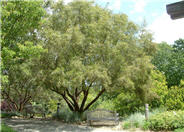
Common name:African Sumac
Botanical name:Rhus lancea
This small, evergreen tree grows slowly to 25' and exhibits an open, spreading habit. Its leaves are dark green, glossy, and divided into 3 willow-like leaflets 4"-5" long. The bark has a dark red color. The tree has males and females. It often has a drooping habit and is prone to Texas Root Rot.
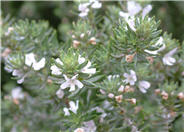
Common name:Coast Rosemary
Botanical name:Westringia fruticosa
The Australian Rosemary is an evergreen shrub that grows 3'-6' tall. It has soft, gray green leaves and white flowers throughout the year and prefers sun and little to average amounts of water. This shrub is also drought tolerant. -Cornflower Farms
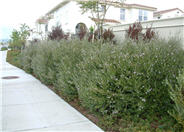
Common name:Westringia Wynyabbie Gem
Botanical name:Westringia 'Wynyabbie Gem'
This evergreen shrub will grow 3'-6' high and 6'-8' wide and has lavender flowers that bloom from February through spring. It is drought tolerant and does well in full sun or partial shade.
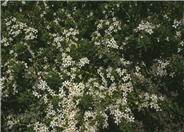
Common name:Wide-Leaf Myoporum Putah Creek
Botanical name:Myoporum parvifolium 'Putah Creek'
This evergreen groundcover grows 1' high and 8' wide. It is drought tolerant once established and blooms with white flowers in the summer. It cannot take foot traffic. Leaves are bright green and held close to the stems. This shrub is great for erosion control. It tolerates ocean spray as well as heat.
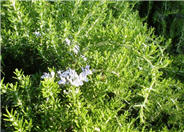
Common name:Rosemary
Botanical name:Rosmarinus officinalis
Rosemary is hardy in full sun areas where winter temperatures do not drop below 10 degrees F. They can be grown in a clay pot with well-drained, porous soil in bright indoor light, and will also flourish on the backporch in spring, summer and fall. Its beautiful, slowly trailing stems and shiny slender leaves are perfect for showing off the small, light blue flowers that blossom in the summer. -Holland WIldflower Farm
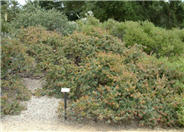
Common name:John Dourley Manzanita
Botanical name:Arctostaphylos 'John Dourley'
This small, low growing shrub has grayish green leaves with pink and white flowers that bloom in winter and early spring.
| Designer: Anon | Shrubs on Hillside |
Photographer: GardenSoft |
Soils and Compost:
Physical weed control, including mulching, or hand removal protects the watershed from harmful chemicals.
Water Saving Tip:
Replace turf with groundcovers, trees, and shrubs. If you have areas where no one uses the grass, patches that do not grow well, or a turf area too small to water without runoff, consider replacing the turf with water-efficient landscaping.
Integrated Pest Management:
Remove irrigation water and fertilizer from areas where you don't want weeds to grow.
